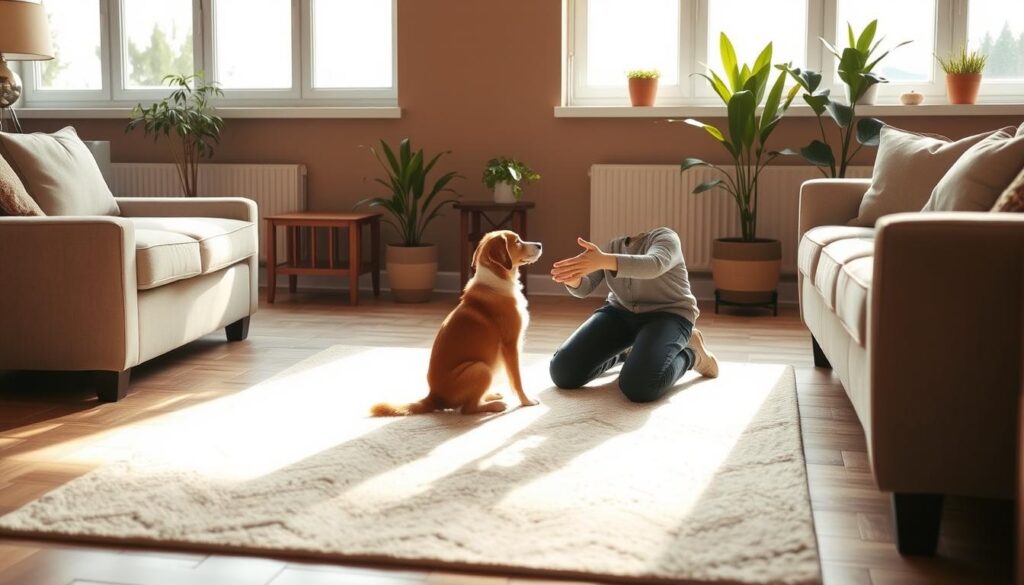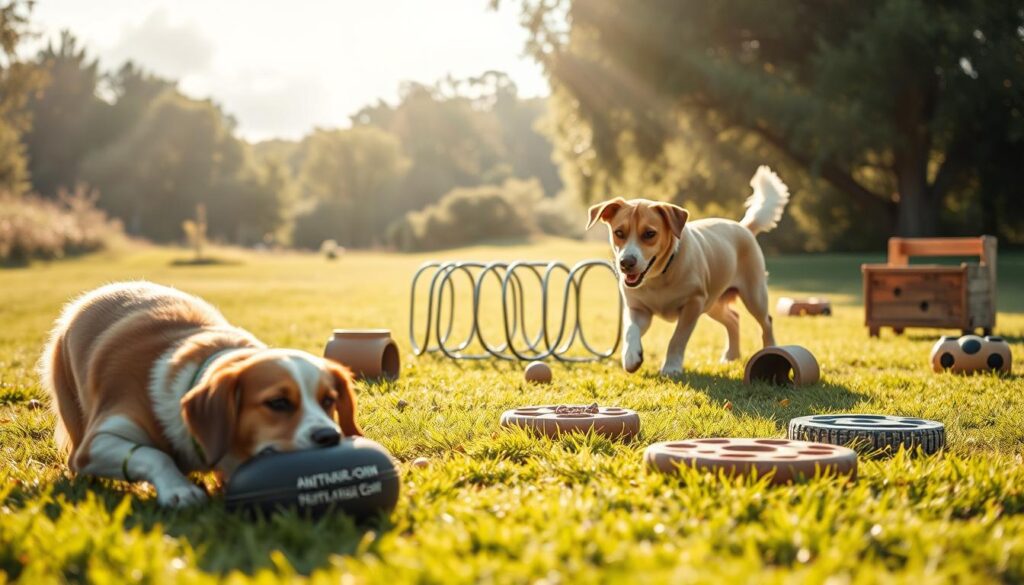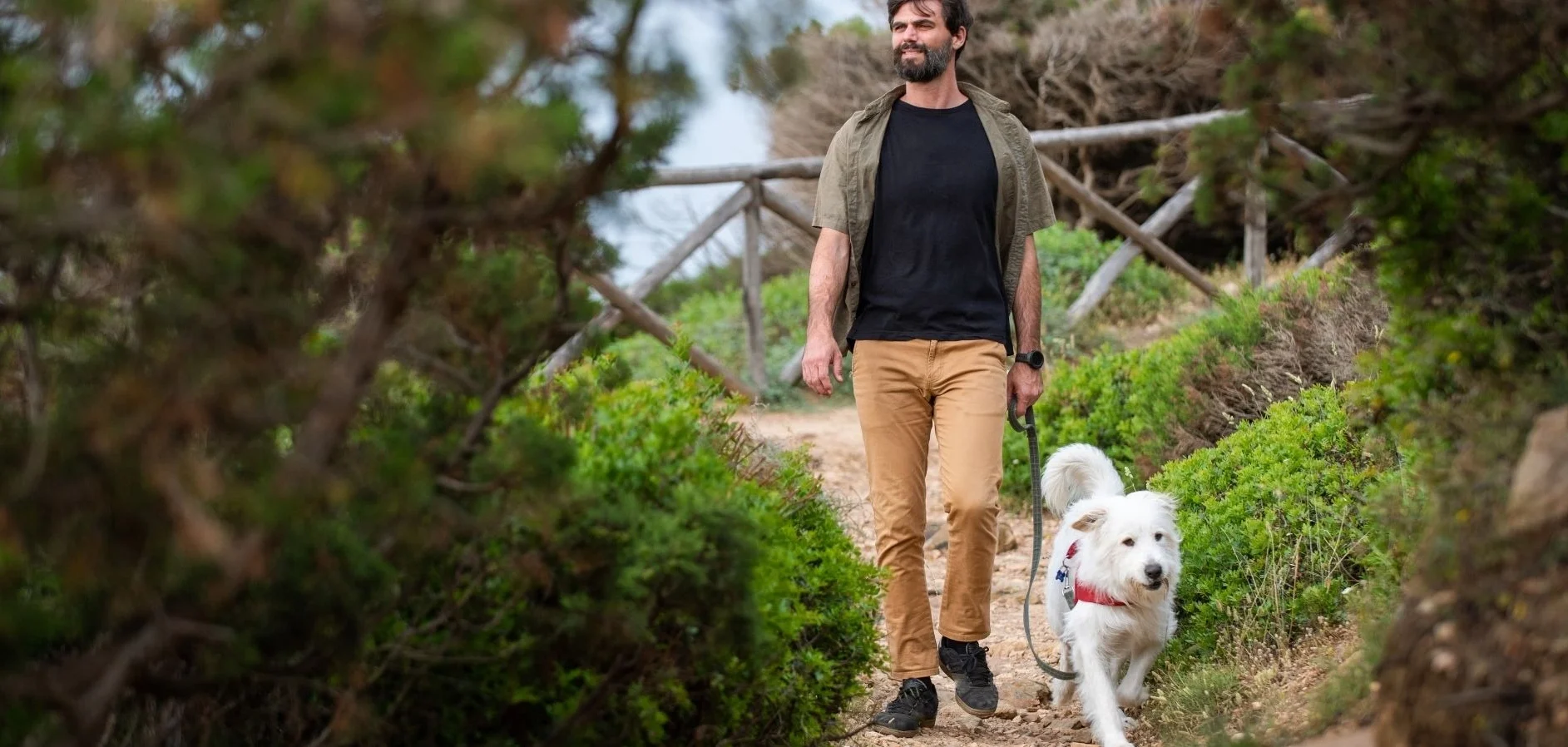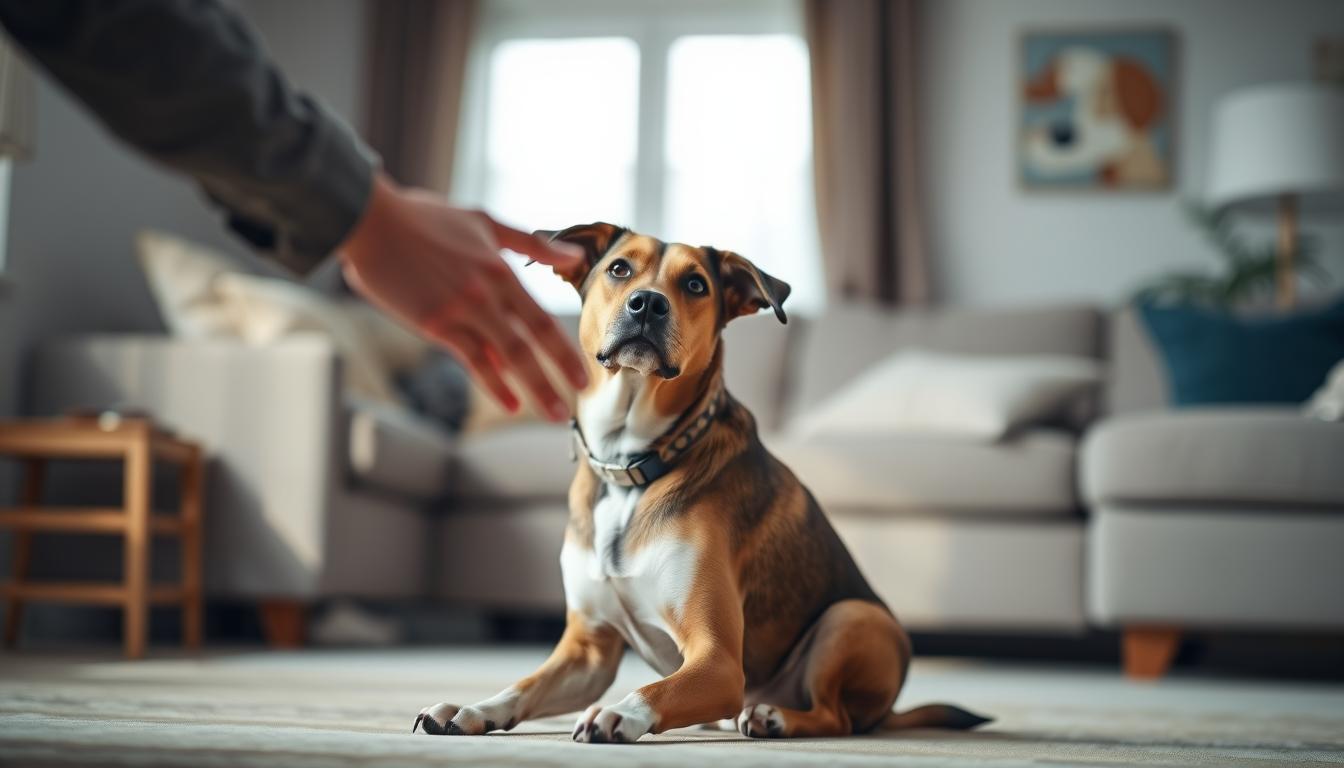How to Teach a Dog to Sit and Stay Calm in Any Situation
Table of Contents
How to teach a dog to sit isn’t just about commands — it’s about connection. Every dog owner knows that moment of frustration or excitement when their pup won’t listen. Teaching your dog to sit and stay builds more than obedience — it builds trust, confidence, and a loving bond that lasts.
Dog training techniques for sit and stay are not just simple commands. They are a way to communicate with your dog, teaching them about boundaries and helping them feel confident. Whether your dog is hyperactive or nervous, learning these skills can change your relationship for the better.
It’s important to understand your dog’s emotions. Dogs show stress through signs like ear position, tail movement, and body tension. By noticing these signs, you can help your dog stay calm and in control.
Key Takeaways
- Sit and stay commands are fundamental to dog training
- Emotional understanding is crucial in training
- Consistent practice builds dog confidence
- Training reduces anxiety in dogs
- Communication is more important than strict discipline
Understanding Dog Behavior and Learning Patterns
Training your dog to sit and stay needs a deep understanding of dog psychology and learning. Dogs are smart and do best with clear, consistent messages and positive rewards. This makes teaching them sit and stay a rewarding experience.
Dogs learn through a complex process called associative learning. Their brains link actions with rewards, making positive reinforcement key to successful training.
How Dogs Process Commands and Instructions
Canine learning involves several key cognitive processes:
- Associative memory connection
- Sensory input recognition
- Reward-based motivation
- Pattern recognition
The Role of Positive Reinforcement in Training
Positive reinforcement makes training fun and builds a strong bond. Reward-based methods create a deep emotional connection between you and your dog.
| Training Method | Effectiveness | Dog Engagement |
|---|---|---|
| Positive Reinforcement | High | Excellent |
| Punishment-Based | Low | Poor |
Reading Your Dog’s Body Language
Understanding your dog’s non-verbal signals is key in teaching commands. Small signs like ear position, tail movement, and eye contact show their feelings during training.
Successful training is about communication, not domination.
Essential Training Supplies and Setup
To master sit and stay commands, you need the right gear and a good training area. Success in teaching your dog these commands depends on the right tools and a great learning space.
Before you start, make sure you have these key items:
- High-quality training treats
- Comfortable, well-fitted harness
- 6-foot training leash
- Clicker (optional but recommended)
- Treat pouch
Choosing the right treats is key to keeping your dog motivated. Select small, soft treats that can be quickly consumed during training. This helps keep your dog focused on learning sit and stay commands.
| Training Supply | Purpose | Recommended Type |
|---|---|---|
| Treats | Reward and motivation | Small, soft, high-value treats |
| Harness | Control and comfort | No-pull, adjustable design |
| Leash | Training management | 6-foot lightweight training leash |
Your training area should be quiet and free from distractions. Start in a familiar indoor space before moving to outdoor areas. Keeping your training setup consistent helps your dog learn better.
How to Teach a Dog to Sit and Stay
Teaching your dog to sit and stay needs patience, consistency, and the right methods. Learning these commands helps you communicate better with your dog. Professional trainers suggest breaking these skills into easy steps for fun learning.
Good training starts with knowing how your dog learns and what motivates them. Since every dog is different, keep training sessions short and positive.
Basic Sit Command Technique
Teaching your dog to sit is simple:
- Hold a treat near their nose
- Move the treat up and back over their head
- As they look up, their bottom will lower
- Say “Sit” and give them the treat when they sit
- Do this many times
Adding the Stay Command
When your dog knows how to sit, teach them to stay with these steps:
- Have them sit
- Show them your open palm
- Say “Stay” in a calm voice
- Take a small step back
- Give them a treat if they stay
- Slowly increase how far and long you’re away
Common Training Mistakes to Avoid
Training your dog right means avoiding common mistakes:
| Mistake | Solution |
|---|---|
| Inconsistent commands | Always use the same words and signals |
| Long training sessions | Keep it short (5-10 minutes) |
| Punishing mistakes | Focus on positive rewards instead |
Every dog learns at their own speed. Be patient and use positive rewards to help them learn.
Creating a Calm Training Environment

Learning to teach a dog to sit and stay starts with the right environment. A calm, distraction-free space is key. It helps your dog focus and learn better during training.
To create the perfect atmosphere, follow these steps:
- Choose a quiet room with minimal external noise
- Remove potential distractions like toys or other pets
- Maintain a consistent, comfortable temperature
- Use soft lighting to reduce visual stimulation
Sensory elements greatly affect your dog’s training. Calming scents like lavender or gentle sounds can reduce anxiety. Soft classical music or white noise can make the environment soothing for learning.
Your dog’s mental state is just as crucial as the physical space. Make sure they are well-rested and calm before training. A short walk or play session can help them relax and focus.
“A calm dog learns faster and retains commands more effectively.”
Interactive puzzle toys are great for keeping your dog calm during breaks. They provide mental stimulation and prevent restlessness. This makes training sessions more productive and fun.
Building Duration and Distance in Stay Commands
Teaching your dog to sit and stay takes time and careful steps. Start by increasing the time and distance of the stay. This builds a solid base for your dog’s obedience.
- Start with short 3-5 second stays in a quiet environment
- Gradually increase duration to 30 seconds
- Slowly add distance between you and your dog
- Introduce mild distractions incrementally
Progressive Training Steps
Begin in a calm, familiar area. Ask your dog to sit, then say “stay” with a clear hand signal. Take one step back, then return and reward. Consistent practice builds confidence.
Dealing with Distractions
When your dog gets better, add controlled distractions. Start with small movements or soft sounds. Reward your dog for staying calm despite these distractions.
Reinforcement Schedules
Use a variable reinforcement schedule to keep your dog interested. Sometimes reward right away, other times wait a bit. This keeps your dog focused and prevents them from getting bored.
“Consistency and patience are your greatest tools in dog training.” – Professional Dog Trainer
Managing Excitement and Stress During Training
Training your dog to sit and stay can be tough when they get too excited or stressed. It’s important to know when your dog is feeling overwhelmed. Dogs show stress through certain body language cues that tell owners they need help.
Look out for these stress signs during training:
- Excessive panting
- Whale eye (showing the whites of their eyes)
- Tucked tail
- Ears pinned back
- Frequent yawning
If you see these signs, it’s time to calm your dog down. Short, positive training sessions work best. Break down big commands into smaller steps that don’t stress your dog out.
“Training should be a positive experience that builds confidence, not creates anxiety.” – Professional Dog Trainer
Here are some ways to manage stress in dog training:
- Taking frequent breaks
- Using calming praise and low-stress rewards
- Creating a quiet, distraction-free training environment
- Practicing relaxation techniques
- Recognizing your dog’s individual stress triggers
Every dog is different when it comes to training. Being patient and understanding is crucial. It helps your dog learn sit and stay commands while staying calm.
Advanced Training Techniques for Different Situations
Learning dog obedience sit stay commands is not just about the basics. It’s about mastering advanced skills for different situations. This journey tests your patience and your dog’s discipline.
Advanced training tips help you face real-world challenges. These methods turn simple commands into reliable actions in various settings.
Training in Public Spaces
Public areas are full of distractions that test your dog’s focus. Here’s how to train sit and stay commands outside:
- Begin in quiet spots with few distractions
- Use a long leash for safety and control
- Give rewards right away for good behavior
- Slowly add more distractions to the environment
Working with Multiple Dogs
Training multiple dogs needs patience and a clear plan. Start by training each dog separately. This avoids confusion and competition.
- Train each dog alone before group sessions
- Use different commands for each dog
- Give equal time and rewards to each dog
Emergency Recall Methods
Learning an emergency recall is crucial. Create a special command that grabs your dog’s attention in urgent situations.
- Choose a clear, sharp command
- Practice with high-value treats
- Simulate emergency scenarios
- Practice the command often
Advanced dog training requires hard work, consistency, and positive feedback. Your effort turns simple commands into reliable actions.
Using Mental Enrichment to Promote Calmness

Mental stimulation is key in dog training, especially for sit and stay. Dogs need more than just physical exercise to stay calm and focused. Mental games can tire their brains, making training more effective.
Puzzle toys and interactive games are great for dogs. They challenge your dog’s problem-solving skills and reduce excess energy. This helps with sit and stay commands.
- Treat-dispensing puzzle toys
- Hide-and-seek games with treats
- Nose work challenges
- Interactive feeding games
Begin with simple mental challenges and gradually get harder. This builds your dog’s confidence and keeps training fun.
| Activity | Mental Stimulation Level | Training Benefit |
|---|---|---|
| Kong Puzzle Toy | Moderate | Improves focus and patience |
| Snuffle Mat | High | Reduces anxiety and hyperactivity |
| Scent Tracking Games | Very High | Enhances mental discipline |
Remember, mental exhaustion can be more effective than physical exercise in preparing your dog for calm training. By using these mental games, you’ll have a more focused dog during sit and stay training.
Troubleshooting Common Behavioral Issues
Training your dog to sit, stay, and other commands can be tough. Some dogs have trouble controlling their impulses. This makes training them a bit harder.
Fixing common problems needs patience and smart planning. The sit and stay commands help manage bad behaviors like jumping, too much barking, or pulling on the leash.
- Jumping: Use the sit command to interrupt and redirect excited behavior
- Barking: Teach your dog to sit and stay when triggered by external stimuli
- Leash pulling: Implement sit and stay techniques to create calm walking experiences
Teaching your dog to sit and stay helps you communicate better. Consistency is key in changing bad behaviors.
Dogs with impulse control issues need training in small steps. Start in a quiet place with few distractions. Then, make the training harder by adding more challenges.
Remember: Every correction is an opportunity to reinforce positive behavior.
Experts say to use positive rewards. Give your dog a treat right away when they sit and stay well, even when it’s hard.
Maintaining Long-term Training Success
To keep your dog’s sit and stay skills sharp, you need to be dedicated and strategic. Training your dog is not a one-time thing. It’s an ongoing journey that needs consistent effort and flexibility.
For long-term success in dog training, several key strategies are essential. They help keep your dog’s skills strong and prevent them from fading away.
Creating Consistent Practice Routines
Regular training sessions are key to keeping your dog’s skills sharp. Short, frequent practice sessions are best for reinforcing sit and stay commands.
- Practice 5-10 minutes daily
- Mix training locations
- Use varied distractions
- Reward consistently
Adapting to New Training Environments
Dogs learn best when faced with new challenges. Gradually introduce new environments to test and strengthen their sit and stay skills.
| Environment | Training Focus | Difficulty Level |
|---|---|---|
| Home | Basic Command Reinforcement | Low |
| Park | Distraction Management | Medium |
| Busy Street | High-Stimulus Control | High |
Effective Refresher Training Tips
Regular refresher sessions are important to keep your dog’s training sharp. Watch for signs of skill decline and address them quickly.
- Review basic commands weekly
- Use positive reinforcement
- Keep training sessions engaging
- Adjust difficulty progressively
Remember, patience and consistency are your greatest tools in maintaining your dog’s sit and stay skills.
Conclusion
Training your dog to sit and stay needs dedication and understanding. It’s not just about commands. It’s about building a strong bond with your furry friend.
Effective training comes from patience and consistency. Each session is a chance to grow closer and create a calm space. Positive reinforcement helps your dog feel secure and understand what you expect.
Remember, progress is slow but steady. Some days will be better than others. But keep going. Professional trainers say short, regular sessions work best.
Keep practicing and adapting to your dog’s personality. Enjoy the journey of building a strong connection. With time, your dog will become well-behaved and confident, following your guidance.
FAQ
How long does it typically take to teach a dog to sit and stay?
The time needed to teach a dog to sit and stay varies. It depends on the dog’s age, breed, and past training. Most dogs can learn these commands in 2-4 weeks with daily practice of 5-10 minutes.
Puppies might learn faster, while older dogs need more patience and repetition.
What if my dog gets distracted during training?
Dogs often get distracted during training. Start in a quiet place with few distractions. Then, add more distractions as your dog gets better.
Use treats that your dog loves, keep sessions short, and always end on a positive note. If your dog gets too distracted, go back to a simpler place and rebuild their focus.
Can older dogs learn sit and stay commands?
Yes, older dogs can learn new commands too. They might need more patience and consistent positive reinforcement. Use gentle, reward-based training and adjust your expectations based on their physical abilities and past experiences.
What treats work best for training?
Choose small, soft treats that your dog can eat quickly. High-value treats like cooked chicken, cheese, or training treats work well. These treats should be motivating but also healthy and low in calories.
How do I handle my dog’s excitement during training?
Keep training calm and structured to manage excitement. Use a consistent tone of voice and start with short sessions. Practice in a quiet place.
If your dog gets too excited, take a break and then start again with calmer activities. Reward calm behavior and gradually increase the challenge.
Is it possible to train multiple dogs at the same time?
Training multiple dogs at once is challenging but possible. First, train each dog separately to build their skills. Once they know basic commands, you can start group training.
Use separate treat pouches, give each dog individual attention, and be ready to work with dogs at different learning speeds.
What if my dog refuses to stay?
If your dog refuses to stay, it might be due to lack of motivation, unclear commands, or too much difficulty. Break the stay command into smaller steps and use high-value rewards.
Start with very short durations and gradually increase the time and distance. Always set your dog up for success with realistic expectations.
How often should I practice sit and stay commands?
Practice sit and stay commands 2-3 times a day for 5-10 minutes. Integrate them into your daily routine, like before meals or walks. Consistent practice helps make these commands second nature to your dog.
There are no reviews yet. Be the first one to write one.



Comments are closed.